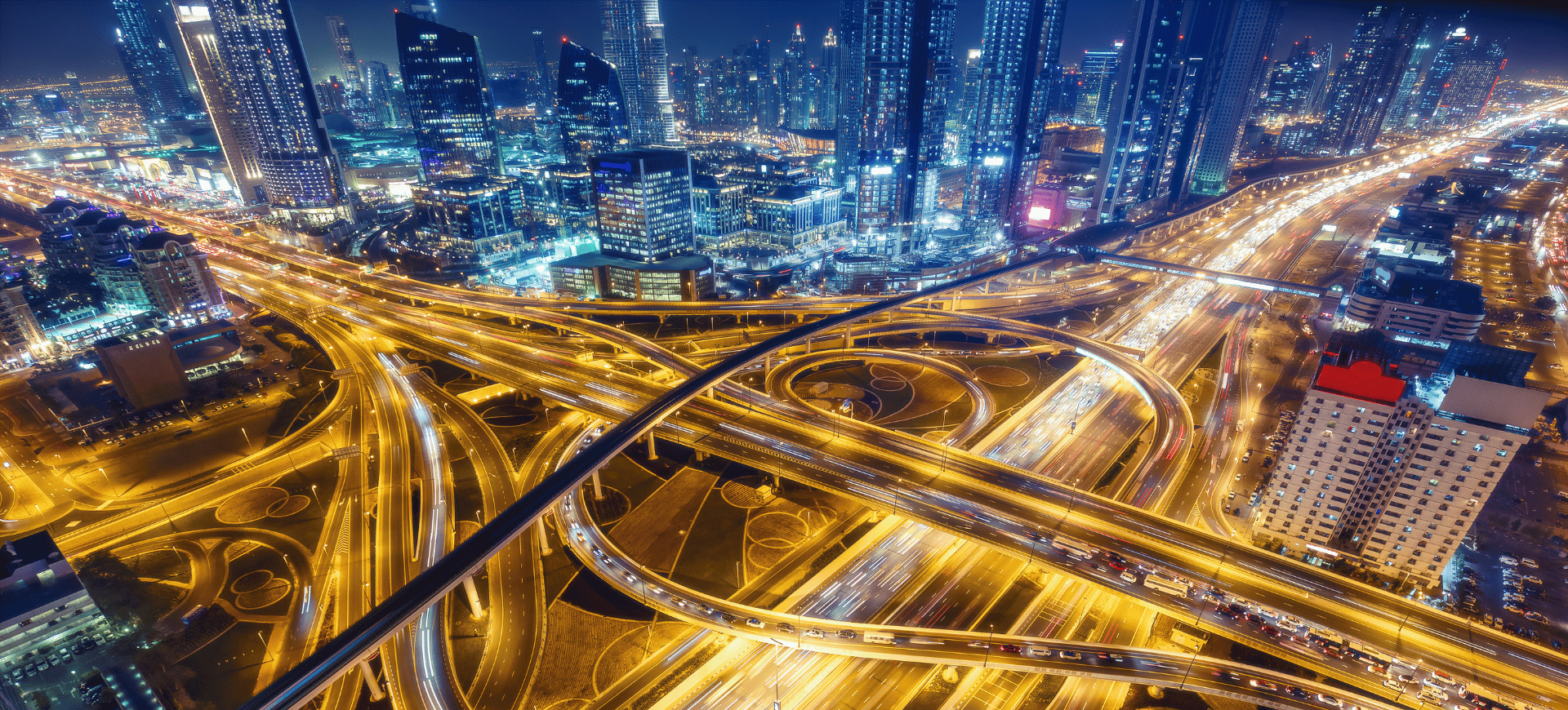Driving the Future: How the UAE is Leading the Charge in E-Mobility and Smart Transportation
Transformation, sweeping reforms and embracing sustainability – these factors are at the heart of the UAE’s ongoing economic success story, as the country transitions into the next phase of its technology-led growth and regional leadership.
The economic reshaping of the UAE remains fast, and the pace is still accelerating. In 1971, 90% of the UAE’s GDP came from its burgeoning oil sector. By 2023, a mere 52 years later, this proportion had shrunk to just 30%. While oil and gas are still an economic mainstay for the UAE, the rapid development of its increasingly smart cities and wider infrastructure, renewable energy industry and non-emitting sectors all underlines where its future growth engines are to be found.
Transportation – a crucial element affecting every nation’s environmental health and the everyday lives of its citizens and visitors – is now a vehicle for the UAE’s Net Zero by 2050 ambitions, as it harnesses the power of clean energy, smart solutions and next generation infrastructure to create better, safer, cheaper and cleaner ways to get millions of people from A to B.
2024 Pulse Check – Where is UAE on its smart transportation ambitions?
Smart and sustainable mobility is a highly visible part of both the broader national strategies (Net Zero, We the UAE 2031, etc) and the specific development plans at the emirate and city level. Converting policy into practical adoption methods for emerging technologies isn’t easy, but it appears to be meeting sustained success in the UAE.
2024 has been yet another year of solid, demonstrable progress regarding the UAE’s targets on electric vehicle (EV) adoption, integration of autonomous vehicles and smart transportation solutions, and the ongoing partnership between the public and private sectors to make favourable, workable policies that encourage change at a fast yet equitable pace.
For EVs, Dubai is the foremost emirate in the growing national adoption trend — according to DEWA there were almost 26,000 on the roads there at the end of December 2023 — a jump of more than 70% from 2022. EV charging stations – essential to the transition – are also widening their footprint, with around 382 in Dubai and 250 in Abu Dhabi. Both emirates have set their sights much higher. Dubai, steered by DEWA, aims to triple its charging stations to over 1,000 by the end of 2025, while Abu Dhabi has ADNOC and TAQA targeting an expansion to 70,000 charging points across the emirate by 2030.
Pushing the EV adoption rate relies on fusing convenience with economics. The UAE government continues to make the case for EVs by setting favourable, stable tariffs for consumer charging, tax breaks (for consumers and manufacturers/service providers), low interest loans and other incentives. The public sector has led the way: 20% of federal government agency vehicles are now EVs. This prompted an upwards revision of the target to have at least 50% of all such government vehicles using EV or hybrid powertrains by the end of 2050.
This combination of financial incentivisation, improved infrastructure access and the increasingly attractive total cost of ownership (the cost of purchasing, owning and operating the vehicle) has led to a tangible shift in UAE consumer mentality. The prospect of owning an EV is no longer fanciful – it is a viable consideration for a growing proportion of UAE motorists looking for a better long-term prospect for the environment and their household budget.
Public transport
Public transport is as vital as private vehicle ownership in completing the sustainable transportation puzzle. Here, the UAE has much to celebrate in 2024 as well. The central target of making 25% of all transportation modes autonomous by 2030 continues to galvanise efforts in adopting driverless taxis, buses, trams, trains and more.
In December 2024, driverless taxis, dominating headlines for years, became a commercial reality for the first time in the history of the Middle East. Uber and WeRide launched the service in areas of Abu Dhabi including Saadiyat Island and Yas Island and routes to and from Zayed International Airport. While safety operators remain behind the wheel for now, the companies involved aim to phase them out during 2025, allowing the taxis to become fully autonomous.
This is just one example of how smart transportation concepts that were pipe dreams a decade ago are now a purchasable service in the UAE. Flying taxis are due to make this leap from theory to reality; last November it was confirmed that the country’s first ‘vertiport’ is being built at Dubai International Airport, and by early 2026 you’ll be able to take a trip to Dubai Marina, Downtown or the Palm Jumeirah, in roughly a third of the time it would take to go by car.
Infrastructural plans remain high on the priority list. Foremost among them include July 2024’s announcement of the Dubai Green Spine megaproject, creating a 64-kilometre-long highway that will act as a sustainable corridor. Electric trams running on 100% renewable energy will glide over solar panels running the length of the highway, with each side bracketed by urban farms and gardens, further promoting biodiversity, sustainability and improved public health.
Alongside renewed interest in jumpstarting the stalled Dubai Hyperloop project (feasibility studies have resumed after new plans for an Italy-based system were announced), the development of highly advanced, ambitious and well-funded transportation projects remains a priority for the UAE government and its urban planning priorities for the rest of the decade and beyond.
Will 2025-2030 Cement the UAE’s Dominance in E-Mobility and Smart Transportation?
The next five years will be crucial in building momentum for the smart transport systems and concepts that are already in place or in their infancy across the UAE.
Taking EVs, all necessary components are in place to rapidly accelerate the transition from ICE to electric and hybrid powertrains. Though the UAE currently lacks the availability (around 90% of vehicles in dealerships are ICE) and infrastructure to make EVs a viable mass-market consumption option, its government and individual operators have repeatedly demonstrated a strong willingness to work together, reinforce these early successes and approach each factor necessary to make EV ownership more attractive.
With ambitious targets to massively upscale the availability of EV models and charging stations, while keeping operating costs low with favourable policies, the UAE is on the right course to make EVs a sizeable proportion of vehicles on its roads by the decade’s end. By then, EVs should represent at least 15% of all new vehicles sold to the public, and 25-30% of all government-owned vehicles.
Similarly, the first four years of the 2020s have already shown that there is significant appetite from the UAE government and private sector to implement advanced public transportation projects. While many are impressive in scale and design, such as Dubai Green Spine and the Hyperloop, equally important are the smaller and more gradual integrations of smart solutions into citywide, emirate-wide and nationwide transport systems. For every autonomous taxi, driverless tram car and cashless bike hire available to the public, the broader smart transport agenda is pushed forward, proving the commercial case for such technologies and encouraging other institutions (private and public) to reinforce their success.
Policy and commercial prospects are creating a smart transport boom
The UAE’s strengthening prospects as a global leader in e-mobility and smart transportation are driven by three factors – substantial investments, a willingness to embrace technological advancements, and a consistent commitment from the government towards sustainable development.
At every turn, we can see a deepening acceptance that advanced digital technologies are vital to overhauling and futureproofing the UAE’s entire transportation network. This visualisation of transport systems that are increasingly cashless, seamless and autonomous has become ingrained, not just in government policy, but also in the minds of commercial enterprises that see the UAE as fertile ground for their ideas and capital investments.
If this pace of change and level of ambition can be maintained, the rest of the decade should be pivotal in turning the UAE into a global standard bearer for smart transportation. Just as each technology and new mode of transportation enjoys greater presence and market share, there is a broader opportunity to demonstrate their full potential by joining up the entire ecosystem and allowing everyday users to complete their journey of any distance using clean, affordable, safe and convenient public transport options that best suit their schedule.











